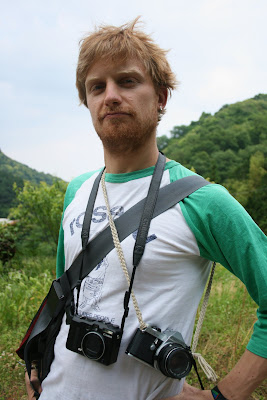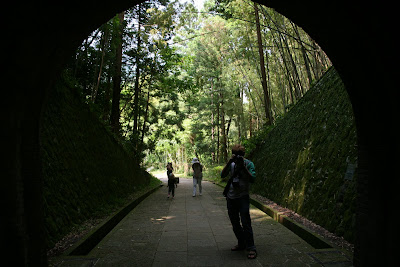Just beyond the city limits of Shizuoka City is Utsunoya Pass, a once-daunting mountain crossing that travelers on the Old Tokaido Road (the historic route from Tokyo to Kyoto) hiked between the villages of Mariko (in present-day Shizuoka City) and Okabe (recently incorporated into Fujieda City). We set off with cameras to first visit the tiny settlement of Utsunoya, a strip of traditional houses nestled alongside the mountain.









This photo was inspired by Yuna, our photographer friend who has a thing for rust:

Despite having been warned by my students and Shizuokan friends that the place is haunted (cameras malfunctioning in/around the place, people feeling strange, ooOOOoooo!), we hiked up to the entrance of the Meiji Tunnel, the first tunnel through Utsunoya Pass, constructed in 1876.

Ain't afraid of no ghosts. Besides, the tunnel's only 200 meters long...





Really, the only spooky part was that it had started to thunder when we exited the other side (below is the view of Utsunoya Pass from the Okabe side...a 4-lane highway now cuts through the mountain below the site of the old Meiji Tunnel).


Then, as we waited for the bus, it poured...rainy season, after all. This visit was one more check off my "must-see before moving home" list. And sorry for the misleading title...not even any strange white shapes showed up on our developed photos.








 This photo was inspired by Yuna, our photographer friend who has a thing for rust:
This photo was inspired by Yuna, our photographer friend who has a thing for rust: Despite having been warned by my students and Shizuokan friends that the place is haunted (cameras malfunctioning in/around the place, people feeling strange, ooOOOoooo!), we hiked up to the entrance of the Meiji Tunnel, the first tunnel through Utsunoya Pass, constructed in 1876.
Despite having been warned by my students and Shizuokan friends that the place is haunted (cameras malfunctioning in/around the place, people feeling strange, ooOOOoooo!), we hiked up to the entrance of the Meiji Tunnel, the first tunnel through Utsunoya Pass, constructed in 1876. Ain't afraid of no ghosts. Besides, the tunnel's only 200 meters long...
Ain't afraid of no ghosts. Besides, the tunnel's only 200 meters long...



 Really, the only spooky part was that it had started to thunder when we exited the other side (below is the view of Utsunoya Pass from the Okabe side...a 4-lane highway now cuts through the mountain below the site of the old Meiji Tunnel).
Really, the only spooky part was that it had started to thunder when we exited the other side (below is the view of Utsunoya Pass from the Okabe side...a 4-lane highway now cuts through the mountain below the site of the old Meiji Tunnel).
 Then, as we waited for the bus, it poured...rainy season, after all. This visit was one more check off my "must-see before moving home" list. And sorry for the misleading title...not even any strange white shapes showed up on our developed photos.
Then, as we waited for the bus, it poured...rainy season, after all. This visit was one more check off my "must-see before moving home" list. And sorry for the misleading title...not even any strange white shapes showed up on our developed photos.






 Gyeongbokgung is the bigger, main palace complex (with guards!):
Gyeongbokgung is the bigger, main palace complex (with guards!):


 Then I left the palace district and walked through the city center to the markets. On the way I passed elaborate lanterns, fountains, and some funky urban art. I even saw a herd of cyclists assembling for a Critical Mass ride! Seoul is a very cool city, with lots happening above ground and below in the underground markets.
Then I left the palace district and walked through the city center to the markets. On the way I passed elaborate lanterns, fountains, and some funky urban art. I even saw a herd of cyclists assembling for a Critical Mass ride! Seoul is a very cool city, with lots happening above ground and below in the underground markets. 






 Once I picked up a bundle of Korean nori (Korean seaweed is slightly thinner and saltier than Japanese seaweed) from an open-air market, I was set to return to Japan, for a direct-comparison taste test, and to live it up for the few weeks I had left before moving home to the States!
Once I picked up a bundle of Korean nori (Korean seaweed is slightly thinner and saltier than Japanese seaweed) from an open-air market, I was set to return to Japan, for a direct-comparison taste test, and to live it up for the few weeks I had left before moving home to the States!
 My first day in Seoul, I jumped on the opportunity to take a ½ day tour of the DMZ. With the sinking of the Cheonan, security was tightened, but tours remained in operation (eventually, with South Korea’s formal accusation of North Korea as the culprit for torpedoing the ship, many tours were suspended); I was able to visit the family reunification area, a tunnel dug by North Korea under the DMZ toward Seoul, a hazy overlook, and a train station built for Sunshine Policy propaganda.
My first day in Seoul, I jumped on the opportunity to take a ½ day tour of the DMZ. With the sinking of the Cheonan, security was tightened, but tours remained in operation (eventually, with South Korea’s formal accusation of North Korea as the culprit for torpedoing the ship, many tours were suspended); I was able to visit the family reunification area, a tunnel dug by North Korea under the DMZ toward Seoul, a hazy overlook, and a train station built for Sunshine Policy propaganda.


 Next we got to walk down into one of the tunnels that the North Korean military dug under the DMZ toward Seoul; this was the third of four tunnels uncovered by officials, though it's suspected that many more exist. Donning hardhats, our group hiked down into the dripping, low-ceilinged tunnel, walls dotted with dynamite holes and painted black so that if discovered, the North Koreans could assert that the tunnel was an abandoned coal mine (even though the area is granite).
Next we got to walk down into one of the tunnels that the North Korean military dug under the DMZ toward Seoul; this was the third of four tunnels uncovered by officials, though it's suspected that many more exist. Donning hardhats, our group hiked down into the dripping, low-ceilinged tunnel, walls dotted with dynamite holes and painted black so that if discovered, the North Koreans could assert that the tunnel was an abandoned coal mine (even though the area is granite).
 Next we visited an overlook: no cameras past the yellow line. Hands at your sides, but not in your pockets. Absolutely no pointing. You are being watched by the North Korean military. When I put my coin into the binoculars, I could see through the haze to the hills of North Korea, razed of trees both for fuel and to prevent people from finding hiding places.
Next we visited an overlook: no cameras past the yellow line. Hands at your sides, but not in your pockets. Absolutely no pointing. You are being watched by the North Korean military. When I put my coin into the binoculars, I could see through the haze to the hills of North Korea, razed of trees both for fuel and to prevent people from finding hiding places.
 Our final stop was Dorasan Station, a gleaming train station constructed during the Sunshine Policy period of warming between the North and South. This propaganda was meant to encourage North Korea to reunify with the South and resume rail service between Seoul and Pyeongyang. At present, Dorasan Station is the last stop on the line north from Seoul, but if trains were allowed to cross the North's border, people could travel from the southern tip of South Korea all the way to Paris, France! But for now, the South of course remains an island.
Our final stop was Dorasan Station, a gleaming train station constructed during the Sunshine Policy period of warming between the North and South. This propaganda was meant to encourage North Korea to reunify with the South and resume rail service between Seoul and Pyeongyang. At present, Dorasan Station is the last stop on the line north from Seoul, but if trains were allowed to cross the North's border, people could travel from the southern tip of South Korea all the way to Paris, France! But for now, the South of course remains an island.


 Our little group was dropped off in downtown Seoul in the early afternoon, and I wandered my way toward the Seoul Tower for a sunset view of the city.
Our little group was dropped off in downtown Seoul in the early afternoon, and I wandered my way toward the Seoul Tower for a sunset view of the city.




 Aww...locks of love packed onto the wire railings:
Aww...locks of love packed onto the wire railings:






 After perusing the bright and busy shopping district, I took the subway back to the
After perusing the bright and busy shopping district, I took the subway back to the 
